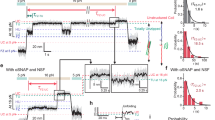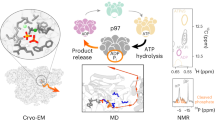Abstract
N-ethylmaleimide-sensitive factor (NSF) is a hexameric ATPase which primes and/or dissociates SNARE complexes involved in intracellular fusion events. Each NSF protomer contains three domains: an N-terminal domain required for SNARE binding and two ATPase domains, termed D1 and D2, with D2 being required for oligomerization. We have determined the 1.9 Å crystal structure of the D2 domain of NSF complexed with ATP using multi-wavelength anomalous dispersion phasing. D2 consists of a nucleotide binding subdomain with a Rossmann fold and a C-terminal subdomain, which is structurally unique among nucleotide binding proteins. There are interactions between the ATP moiety and both the neighboring D2 protomer and the C-terminal subdomain that may be important for ATP-dependent oligomerization. Of particular importance are three well-ordered and conserved lysine residues that form ionic interactions with the β- and γ-phosphates, one of which likely contributes to the low hydrolytic activity of D2.
This is a preview of subscription content, access via your institution
Access options
Subscribe to this journal
Receive 12 print issues and online access
$189.00 per year
only $15.75 per issue
Buy this article
- Purchase on Springer Link
- Instant access to full article PDF
Prices may be subject to local taxes which are calculated during checkout






Similar content being viewed by others
References
Malhotra, V., Orci, L., Glick, B.S., Block, M.R. & Rothman, J.E. Role of an N-ethylmaleimide-sensitive transport component in promoting fusion of transport vesicles with cisternae of the Golgi stack. Cell 54, 221–227 (1988).
Block, M.R., Glick, B.S., Wilcox, C.A., Wieland, F.T. & Rothman, J.E. Purification of an N-ethylmaleimide-sensitive protein catalyzing vesicular transport. Proc. Natl. Acad. Sci. U SA 85, 7852–7856 (1988).
Haas, A. and Wickner, W. Homotypic vacuole fusion requires Sec17p (yeast α-SNAP) and Sec18p (yeast NSF). EMBO J 15, 3296–3305 (1996).
Banerjee, A., Barry, V.A., DasGupta, B.R. & Martin, T.F.J. N-ethylmaleimide sensitive factor acts at a prefusion ATP-dependent step in Ca2+-activated exocytosis. J. Biol. Chem. 271, 20223–20226 (1996).
Mayer, A., Wickner, W. & Haas, A. Sec18p (NSF)-driven release of Sec17p (α-SNAP) can precede docking and fusion of yeast vacuoles. Cell 85, 83–94 (1996).
Sollner, T. et al. SNAP receptors implicated in vesicle targeting and fusion. Nature 362, 318–324 (1993).
Hanson, P.I., Roth, R., Morisaki, H., Jahn, R. & Heuser, J.E. Structure and conformational changes in NSF and its membrane receptor complex visualized by quick freeze/deep-etch electron microscopy. Cell 90, 523–525 (1997).
Confalonieri, F. and Duguet, M. A 200-amino acid ATPase module in search of a basic function. BioEssays 17, 639–650 (1995).
Beyer, A. Sequence analysis of the AAA protein family. Prot. Sci. 6, 2043–2058 (1997).
Tagaya, M., Wilson, D.W., Brunner, M., Arango, N. & Rothman, J.E. Domain structure of an N-ethylmaleimide-sensitive fusion protein involved in vesicular transport. J. Biol. Chem. 268, 2662–2666 (1993).
Morgan, A., Dimaline, R. & Burgoyne, R.D. The ATPase activity of N -ethylmaleimide-sensitive fusion protein (NSF) is regulated by soluble NSF attachment proteins. J. Biol. Chem. 269, 29347–29350 (1994).
Sumida, M., Hong, R.M. & Tagaya, M. Role of two nucleotide-binding regions in an N-ethylmaleimide-sensitive factor involved in vesicle-mediated protein transport. J. Biol. Chem. 269, 20636–20641 (1994).
Whiteheart, S.W. et al. N-ethylmaleimide-sensitive fusion protein: a trimeric ATPase whose hydrolysis of ATP is required for membrane fusion. J. Cell Biol. 126, 945–954 (1994).
Nagiec, E.E., Bernstein, A. & Whiteheart, S.W. Each domain of the N-ethylmaleimide sensitive fusion protein contributes to its transport activity. J. Biol. Chem. 270, 29182–29188 (1995).
Wilson, D.W. et al. A fusion protein required for vesicle-mediated transport in both mammalian cells and yeast. Nature 339, 355–359 (1989).
Hendrickson, W.A. Determination of macromolecular structures from anomalous diffraction of synchrotron radiation. Science 254, 51–58 (1991).
Fleming, K.G. et al. A revised model for the oligomeric state of the N-ethylmaleimide-sensitive fusion protein, NSF. J. Biol. Chem. 273, 15675–15681 (1998).
Peters, J.-M., Walsh, M.J. & Franke, W.W. An abundant and ubiquitous homooligomeric rinγ-shaped ATPase particle related to the putative vesicle fusion proteins Sec18p and NSF. EMBO J 9, 1757–1767 (1990).
Rossmann, M.G., Moras, D. & Olsen, K.W. Chemical and biological evolution of a nucleotide-binding protein. Nature 250, 194–199 (1974).
Holm, L. and Sander, C. Protein structure comparison by alignment of distance matrices. J. Mol. Biol. 233, 123–138 (1993).
Guenther, B., Onrust, R., Sali, A., O'Donnell, M. & Kuriyan, J. Crystal structure of the d' subunit of the clamp-loader complex of E. coli DNA polymerase III. Cell 91, 335–345 (1997).
Walker, J.E., Saraste, M.J., Runswick, J.J. & Gay, N.J. Distantly related sequences in the α- and β-subunits of ATPase, myosin, kinases and other ATP-requiring enzymes and a common nucleotide binding fold. EMBO J 1, 945–951 (1982).
Morgan, A. & Burgoyne, R.D. Is NSF a fusion protein? Trends Cell Biol. 5, 335–339 (1995).
Boisvert, D.C., Wang, J., Otwinowski, Z., Horwich, A.L. & Sigler, PB. The 2.4 Å crystal structure of the bacterial chaperonin GroEL complexed with ATP---S. Nature Struct Biol 3, 170–177 (1996).
Saraste, M. and Sibbald, P.R. The P-loop-a common motif in ATP- and GTP-binding proteins. Trends Biol Sci 15, 430–434 (1990).
Matveeva, E.A., He, P. & Whiteheart, S.W. N-ethylmaleimide sensitive fusion protein contains high and low affinity ATP-binding sites that are functionally distinct. J. Biol. Chem. 272, 26413–26418 (1997).
Bernard, A. and Payton, M. Fermentation and growth of Escherichia coli for optimal protein production. In Current Protocols in Protein Science. (Coligan,J.E., Dunn, B.M., Plough, H.L., Speicher, D.W. & Wingfield, P.T., Eds) Chapter 5.3 (John Wiley & Sons, Inc., New York; 1995).
Leahy, D.J., Erickson, H.P., Aukhil, I., Joshi, P. & Hendrickson, W.A. Crystallization of a fragment of human fibronectin: introduction of methionine by site-directed mutagenesis to allow phasing via selenomethionine. Proteins 19, 48–54 (1994).
Otwinowski, Z. In Data Collection and Processing. (eds Sawyer, L., Isaacs, N. & Bailey, S.) 56–62 (SERC Daresbury Laboratory, Warrington, UK; 1993).
Brünger, A.T. et al. Crystallography and NMR System (CNS): A new software system for macromolecular structure determination. Acta Crystallogr. D, in the press (1998).
Phillips, J.C. & Hodgson, K.O. The use of anomalous scattering effects to phase diffraction patterson from macromolecules. Acta Crystallogr. A 36, 856–864 (1980).
Pannu, N.S. & Read, R.J. Improved structure refinement through maximum likelihood. Acta Crystallogr. A 52, 659–668 (1996).
Jiang, J.-S. & Brünger, A.T. Protein hydration observed by x-ray diffraction: solvation properties of penicillopepsin and neuraminidase crystal structures. J. Mol. Biol. 243, 100–115 (1994).
Zhang, K.Y.J. & Main, P. Histogram matching as a new density modification technique for phase refinement and extension of protein molecules. Acta Crystallogr. A 46, 41–46 (1990).
Jones, T.A. Zou, J.Y., Cowan, S. & Kjeldgaard, M. Improved methods for building protein models in electron density maps and the location of errors in these models. Acta Crystallogr. A 47, 110–119 (1991).
Rice, L.M. & Brünger, A.T. Torsion Angle Dynamics: Reduced variable conformational sampling enhances crystallographic structure refinement. Proteins 19, 277–290 (1994).
Yu, H.-A., Karplus, M. & Hendrickson, W.A. Restrains in temperature-factor refinement for macromolecules: an evaluation by molecular dynamics. Acta Crystallogr. D 41, 191–201 (1985).
Lenzen, C.U., Oppitz, D., Whiteheart, S.W. & Weis, W.I. Crystal structure of the hexamerization domain of N-ethylmaleimide-sensitive fusion protein. Cell, in the press (1998).
Kabsch, W. and Sander, C. Dictionary of protein secondary structure: pattern recognition of hydrogen-bonded and geometrical features. Biopolymers 22, 2577–2637 (1983).
Thompson, J.D., Higgins, D.G. & Gibson, T.J. CLUSTAL W: improving the sensitivity of progressive multiple sequence alignment through sequence weighting, positions specific gap penalties and weight matrix choice. Nucleic Acids Res. 22, 4673–4680 (1994).
Hofmann, K. & Baron, M.D. Boxshade 3.21 http://www.ch.embnet.org/software/BOX_form.html (1998).
Esnouf, R.M. Bobscript: An extensively modified version of MolScript that includes greatly enhanced coloring capabilities. J. Mol. Graph. Model 15, 132–134 (1997).
The POV-ray Team. Pov-ray -- the persistence of vision raytracer, http://www.povray.org/ (1998).
Kraulis, P. MOLSCRIPT: A program to produce both detailed and schematic plots of protein structures. J. Appl. Crystallogr. 24, 946–950 (1991).
Koradi, R., Billeter, M. & Wüthrich, K. MOLMOL: a program for display and analysis of macromolecular structures. J. Mol. Graphics 14, 51–55 (1996).
Nicholls, A., Sharp, K.A. & Honig, B. Protein folding and association: Insights from the interfacial and thermodynamic properties of hydrocarbons. Proteins 11, 281–296 (1991).
Jorgensen, W.L. and Rives, J.T. The OPLS potential functions for protein energy minimizations for crystals of cyclic peptide and crambin. J. Am. Chem. Soc. 110, 1657–1666 (1988).
Burling, F.T., Weis, W.I., Flaherty, K.M. & Brünger, A.T. Direct observation of protein solvation and discrete disorder with experimental crystallographic phases. Science 271, 72–77 (1996).
Acknowledgements
The authors thank S.C. Stroupe and D. Fasshauer for stimulating discussions, R.B. Sutton for expert advise during the course of the project, C. Ostermeier for aid with crystallization, S.R. Sprang for critical reading of the manuscript, L. Esser for assistance in figure preparation, H. Bellamy for assistance with data collection at SSRL 1-5 (SSRL is funded by the Department of Energy, Office of Basic Energy Sciences; the SSRL Biotechnology Program is supported by the NIH, Biomedical Research Technology Program, Division of Research Resources; further SSRL support is provided by the Department of Energy, Office of Health and Environmental Research), and A. Joachimiak and the Structural Biology Center for assistance with data collection at APS (collected at the 19ID beamline of the Structural Biology Center at the Advanced Photon Source at Argonne National Laboratory: this national user facility is supported by the Office of Health and Environmental Research, U.S. Department of Energy). Support by the National Institutes of Health to A.T.B. is gratefully acknowledged.
Author information
Authors and Affiliations
Corresponding author
Rights and permissions
About this article
Cite this article
Yu, R., Hanson, P., Jahn, R. et al. Structure of the ATP-dependent oligomerization domain of N-ethylmaleimide sensitive factor complexed with ATP. Nat Struct Mol Biol 5, 803–811 (1998). https://doi.org/10.1038/1843
Received:
Accepted:
Issue Date:
DOI: https://doi.org/10.1038/1843
This article is cited by
-
Assessing heterogeneity in oligomeric AAA+ machines
Cellular and Molecular Life Sciences (2017)
-
LRRK2 phosphorylates pre-synaptic N-ethylmaleimide sensitive fusion (NSF) protein enhancing its ATPase activity and SNARE complex disassembling rate
Molecular Neurodegeneration (2016)
-
Shedding light on the expansion and diversification of the Cdc48 protein family during the rise of the eukaryotic cell
BMC Evolutionary Biology (2016)
-
Mechanistic insights into the recycling machine of the SNARE complex
Nature (2015)
-
Structural characterization of full-length NSF and 20S particles
Nature Structural & Molecular Biology (2012)



